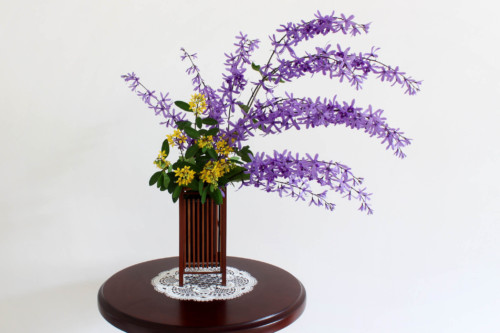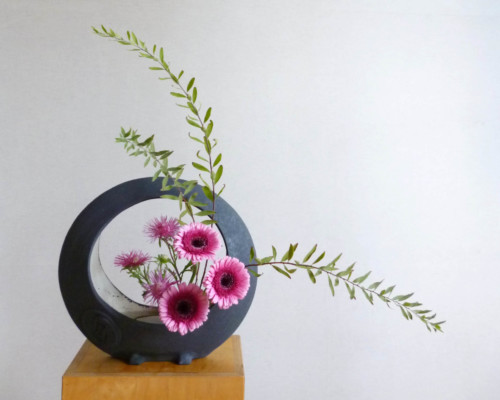Discovering Ikebana, The Art of Japanese Flower Arranging
Before my very eyes, Tisha Kenny, a student of ikebana for 32 years, transformed bouquets from a local flower market into works of art. Two purple irises and several pussy willows became an arrangement called a shoka. Orange lilies, snapdragons in pink and white, gerber daisies, and fig branches were fashioned into a moribana. In a few minutes, the “busy-ness” of the American bouquets (which had too much going on in a riot of colors of shapes) was pared down to something simple, slender, delicate, graceful and sculptural. Less became more.
Kenny, who has done ikebana arrangements for weddings and is also an artist who does Chinese brush-style water colors of flowers, studied at the Ikenobo Ikebana Society of America in San Francisco, where she lives, after she fell in love with Asian floral art forms decades ago. Ikenobo, the oldest and biggest of Japan’s ikebana schools, was founded in Kyoto in the 15th century.
In a few minutes, the “busy-ness” of the American bouquets was pared down to something simple, slender, delicate, graceful and sculptural. Less became more.
Ikenaba is deeply grounded in the Japanese reverence for nature and Buddhist beliefs. “Ikebana is born of nature’s harmony, of the richness of the human spirit, and of a refined and sensitive appreciation for beauty,” writes Sen’ei Ikenobo in The Book of Ikebana. “Though flowers and branches cannot speak, their expression in ikebana is like that of a poem.”
The word ikebana means “flowers arranged according to rule.” Ikenobo literally means “priest’s hut next to the pond,” because the Buddhist monks who made flower offerings at the altar of Buddha at Kyoto’s Rokkakudo Temple, where ikebana began, lived in small huts. The philosophy behind ikebana was established in the 16th century by Senno Ikebono. The same surname is no coincidence: the same family has been head priests of the temple and headmasters of ikebono for almost 500 years.
Leaves and branches are as important as flowers in ikebana. All plant materials are carefully placed to bring out the essence of the plants and present an ideal image of nature, without one element outshining the others.
There are also four basic styles of ikenobo. The most representative style is rikka, a complex arrangement of seven to nine parts that represents the magnificence of nature in a landscape of mountain peaks, streams and villages. Shoka, a simple arrangement of three main parts, conveys the growth of plants reaching upward toward the sky, using plant materials in a natural way. Its three parts – shin, a branch and its central element, is placed first; tai is placed low and in front of shin; soe is behind shin – represent the heavens, earth and man, respectively. Shin should be two-and-a-half to three-and-a-half times the height of the vase, tai is one-third the height of shin, while soe is two-thirds the height of shin.
“Though flowers and branches cannot speak, their expression in ikebana is like that of a poem.”
Moribana, which arranges plants to give a sense of volume and depth, literally means “pile up” plants. In contrast, Free Style, which has no set patterns or rules on how plant materials should be used, expresses the individual creativity and mood of the arranger, who is free to pick based on color, shape or texture alone.
The oldest, rikka, began in the late 16th and early 17th centuries. Shoka evolved in the late 17th to early 18th centuries, while moribana grew in response to Western influences on Japanese culture in the late 19th to early 20th centuries. Free Style reflects modern tastes and contemporary themes.
Plants are cut at an angle with scissors, often bent to achieve the desired effect, and usually inserted in a kenzan, a pin cushion-like base.
Even despite its austere lineage, this ancient art remains relevant today. Noting threats to the environment and spirituality that stem from Westernization and rapid scientific advances, author Ikenobo notes with apt precision: “We need to be reminded of nature and of the beauty of life itself as expressed in the forms of flowers and branches.”





































